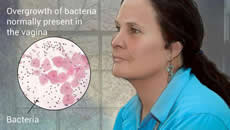Bacterial Vaginosis (BV)
 | Bacterial Vaginosis also called BV or Gardnerella is a bacterial overgrowth in the vagina. Bacterial vaginosis tends to affect women of childbearing age. Activities such as unprotected sexual intercourse or frequent douching can increase a person’s risk. |
What is it?
- Most common cause of abnormal vaginal discharge in women of childbearing age
- It is caused by an imbalance in the bacteria that occur naturally in the vagina
- Up to 50% are asymptomatic
- While BV is not considered as STI, it can be acquired through sexual activity
Signs and Symptoms
Symptoms usually include a white or grey watery vaginal discharge and an unpleasant or ‘fishy’ vaginal odour. Sometimes these symptoms come and go or are more noticeable during menstrual periods.
If you have had BV, there are some things you can do to help prevent further episodes. In particular, avoid smoking, douching or using perfumed talcs or deodorants around your vagina.
Diagnosis
Your GP can make a diagnosis of BV by taking a swab of vaginal discharge and having it examined under a microscope.
Treatment
BV does not necessarily have to be treated if there are no symptoms. However, if you are pregnant, it is important you seek treatment because you can be at risk of complications such as miscarriage and premature delivery.
Treatment is with antibiotics such as metronidazole, tinidazole or clindamycin, which may be given as oral tablets, or a vaginal antibiotic cream or gel. More than one course of treatment may be needed. You can also buy an acidic jelly for the vagina over the counter to help correct the acid balance of the vagina. It is not normally necessary to treat sexual partners, but spread between female sexual partners is possible.
Recommended follow-up
- Not required if symptoms resolve
- Re-testing is recommend for patients if their symptoms persist or recur, as it is important to confirm diagnosis and establish a pattern
- Consider testing for other STIs, if not undertaken at first presentation or re-testing post window period